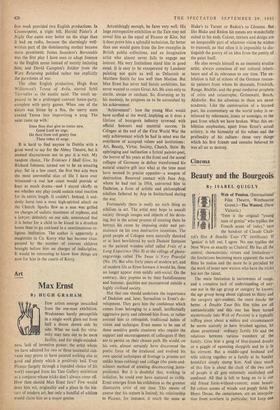Art
Max Ernst
By HUGH GRAHAM Few artists emerge unscathed from the one-man exhibition. Weaknesses barely perceptible in a single work glare out from half a dozen shown side by side. What we took for virtu- osity may turn out to be mere facility, and for single-minded- ness, lack of inventive power; the artist whom we have admired for two or three successful can- vases may prove to have painted nothing else as good and plenty which is positively bad. Even Picasso (largely through a lopsided choice of his work) emerged from his Tate Gallery exhibition as a conjuror whose tricks don't always come off. How then should Max Ernst fare? Few would deny him wit, originality and a place in the his- tory of modern art, but only a handful of addicts would claim him as a major genius. Astonishingly enough, he fares very well. His huge retrospective exhibition at the Tate may not reveal him as the equal of Picasso or Klee, but it does prove him a splendid technician, far better than one would guess from the few examples in British public collections, and an imaginative artist who almost never fails to engage our interest. His very limitations stand him in good stead. It is easy to be exasperated by Landseer painting not quite so well as Delacroix or Matthew Smith far less well than Matisse. But Max Ernst has never had heroic ambitions, has never wanted to create Great Art. He aims only to startle, amuse or enchant. So, disarming us by his modesty, he prepares us to be astonished by his achievement.
'Achievement': how the young Max would have scoffed at the word, implying as it does a lifetime of bourgeois industry crowned with official honours and material success. In Cologne at the end of the First World War the only achievement which he had in mind was the overthrow of accepted values and institutions: Art, Beauty, Virtue, Society, Church, State. By upbringing and inclination a lyrical painter-poet, the horror of his years at the front and the moral collapse of Germany in defeat transformed his natural creative gift into what at the time must have seemed its precise opposite—a weapon of destruction. Renewed contact with Jean Arp, whom he had met in 1914, converted him to Dadaism, a form of artistic and philosophical nihilism fathered by Arp in Switzerland during the war.
Fortunately there is really no such thing as nihilism in art. The artist may hope to assault society through images and objects of his devis- ing, but in the actual process of creating them he betrays his cause by imposing order and per- manence on his own destructive intentions. The good people of Cologne were naturally shocked or at least bewildered by such Dadaist fantasies as the painted wooden relief called Fruit of a Long Experience (No. 8) or the collage of photo- engravings called The Swan is Very Peaceful (No. 19). But after forty years of modern art, and of modern life as Ernst foresaw it would be, these no longer appear even mildly anti-social. On the contrary, they impress us by their fastidiousness and humour, qualities not encountered outside a highly civilised society.
Not that one should underrate the importance of Dadaism and, later, Surrealism to Ernst's de- velopment. They gave him the confidence which comes from belonging to a small, intellectually aggressive party and released him from, or rather assisted him to relinquish, traditional habits of vision and technique. Ernst seems to be one of those sensitive gentle creatures who require the support and encouragement of colleagues if they are to persist on their chosen path. He would, on his own, almost certainly have discovered the poetic force of the irrational and evolved his own special techniques of frottage (a process not unlike brass-rubbing) and collage (the paste-and- scissors method of creating disconcerting juxta- positions). But it is doubtful that, working in isolation, he could ever have matured so richly. Ernst emerges from his exhibition as the greatest illustrative artist of our time. This means of course that his stature is limited; his relationship to Picasso, for instance, is much the same as Blake's to Turner or Redon's to Uzanne. But like Blake and Redon his means are wonderfully suited to his ends. Colour, texture and design are an inseparable part of whatever vision he wishes to transmit, so that often it is impossible to dis- tinguish the poetry of an idea from the poetry of the paint itself.
He also reveals himself as an intensely erudite artist, always conscious of our cultural inheri- tance and of its relevance to our time. The ex- hibition is full of echoes of the German roman- tic painters from whom he descends, Friedrich, Runge, Bocklin, and the great mediteval prophets of crisis and catastrophe, Griinewald, Bosch, Altdorfer. But his allusions to them are never academic. Like the conversation of a learned poet, his commentary on the world today is re- inforced by references, ironic or nostalgic, to the past from which we have broken. What this ex- hibition emphasises, apart from Ernst's actual artistry, is the humanity of his values and the profundity of his culture : those very things which his first friends and enemies believed he was all set to destroy.






































 Previous page
Previous page